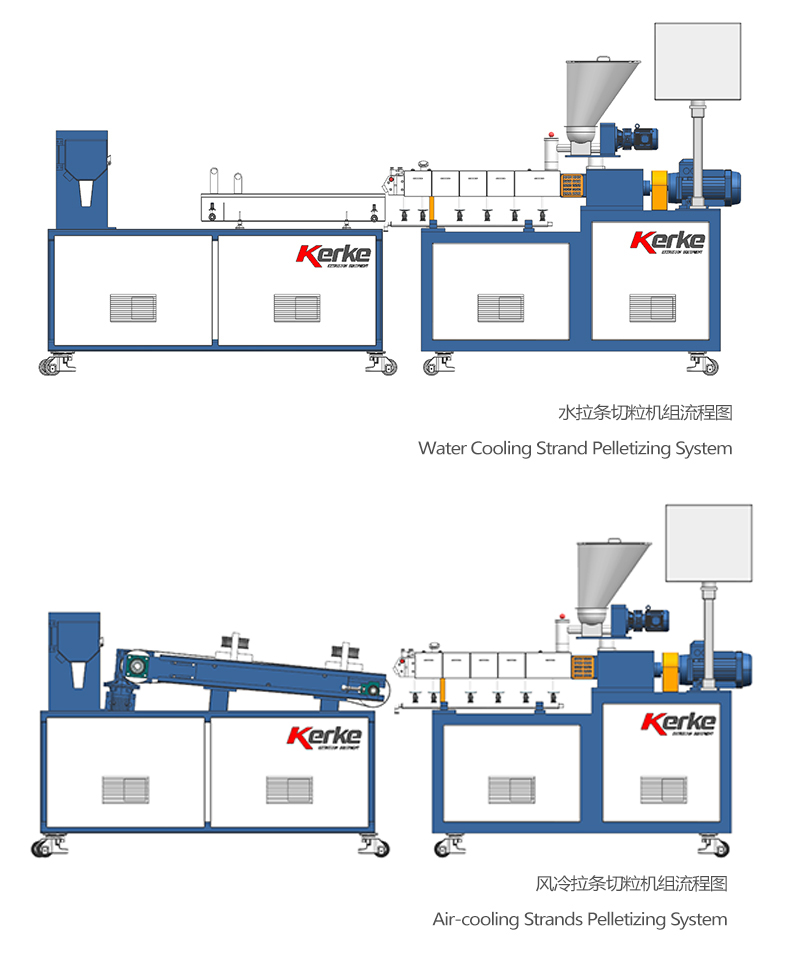KTE Series Laboratory Twin Screw Extruder is Suitable for Formula Development, Mixing, Extrusion and Granulation Experiments of Small Batch of Preliminary Samples, and Can Be Widely Used in Scientific Research Institutes, Laboratories of Major Universities and R&D Centers of Enterprises and Institutions. Its Characteristics Are As Follows:
1) Movable Base, Integrated Design, Compact Appearance and Complete Functions;
2) Plug and Play Design, Easy to Install and Debug;
3) Touch Control System is Adopted, Which is Easy to Operate;
4) It Can Adjust the Required Combination Form According to the Needs of Processing Tasks, and Flexibly Deal with Different Formulas;
5) the Process Parameters Are Stable and Reliable, and Can Be Copied to Mass Industrial Production.

KTE Series Laboratory Twin Screw Extruder is Widely Used in the Processing of Polymer Materials Such As Color Masterbatch, Engineering Plastics, Functional Masterbatch, Elastomer, Degradation Masterbatch and Other Blending Modification Fields.
Our Operating System Adopts Siemens PLC Touch Screen Operating System, Which is Plug and Play, Easy to Operate, and Can Improve the Reliability and Stability of the System.
Siemens PLC System is Widely Used in the Field of Industrial Automation. They Need to Be Integrated into the Control Cabinet to Realize the Control Function of the Control System. the Main Functional Features of Siemens PLC Are As Follows:
1. The Human-machine Interface Function Provides the Operator with the Necessary Information to Monitor the Machine/Process Work. Allow the Operator and PC System to Interact with Their Application Sequence for Decision-making and Adjustment.
2. Communication and Networking Functions Most Modern PLCs Adopt Communication and Network Technology, with RS232 or RS485 Interfaces, Which Can Carry out Remote I/O Control. Multiple PLCs Can Be Networked and Communicated with Each Other. Sequence and Data Exchange, Such As Program Transfer, Data Document Transfer, Monitoring and Diagnosis, Can Be Realized Between External Devices and Signal Processing Units of One or More Programmable Controllers. the Communication Interface or Communication Processor Completes the Transfer of Sequence and Data According to the Standard Hardware Interface or Proprietary Communication Protocol.
3. When the System is Composed, a Distributed Control Network with Centralized Management and Decentralized Control Can Be Formed by One Computer and Multiple PLCs to Complete Large-scale Complex Control. Generally Speaking, the Field End and Remote End of SCA DA System Can Also Use PLC As the Field Machine.
4. The Input/Output Interface Conditioning Function Has A/D D/A Conversion Function, and the Analog Quantity is Controlled and Adjusted Through the I/O Module. Digits and Precision Can Be Selected According to User Requirements.
5. Programming and Debugging Functions:
1) Logic Control of Control Function: PLC Has Logic Operation Functions Such As And, Or, Non, Xor and Trigger, Which Can Replace the Relay to Control the Switching Value.
2) Timing Control: It Provides Users with Several Electronic Timers, Which Users Can Set by Themselves: on Delay, off Delay and Timing Pulse.
3) Count Control: with Pulse Control, You Can Realize the Plus and Minus Count Mode, and You Can Connect the Code Disk for Position Detection.
4) Sequence Control: After the Previous Process is Completed, It Will Be Transferred to the Next Process, So That a PLC Can Be Used As Multiple Stepping Controllers.
6. Data Acquisition, Storage and Processing Function, Mathematical Operation Function.

*
*